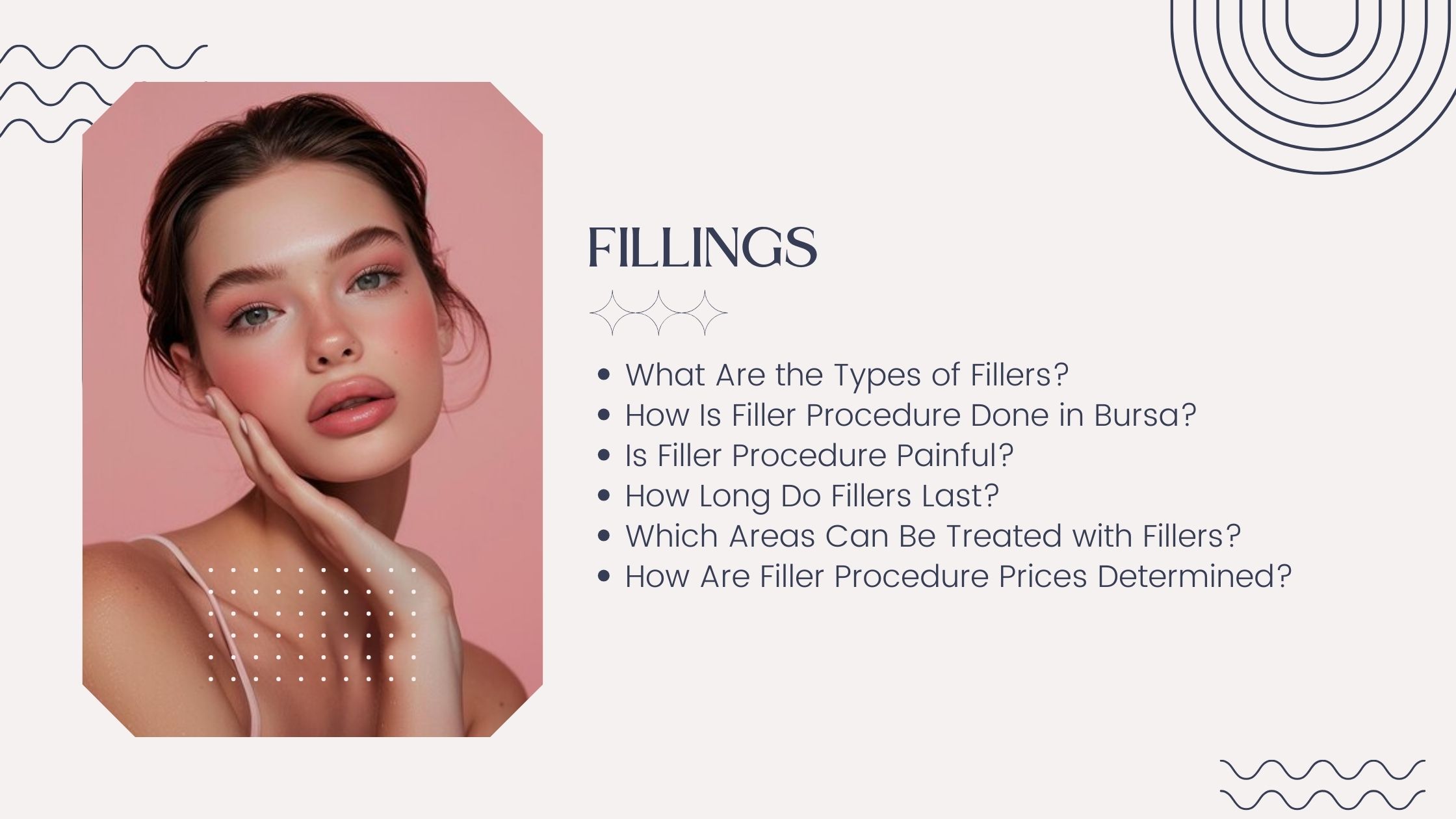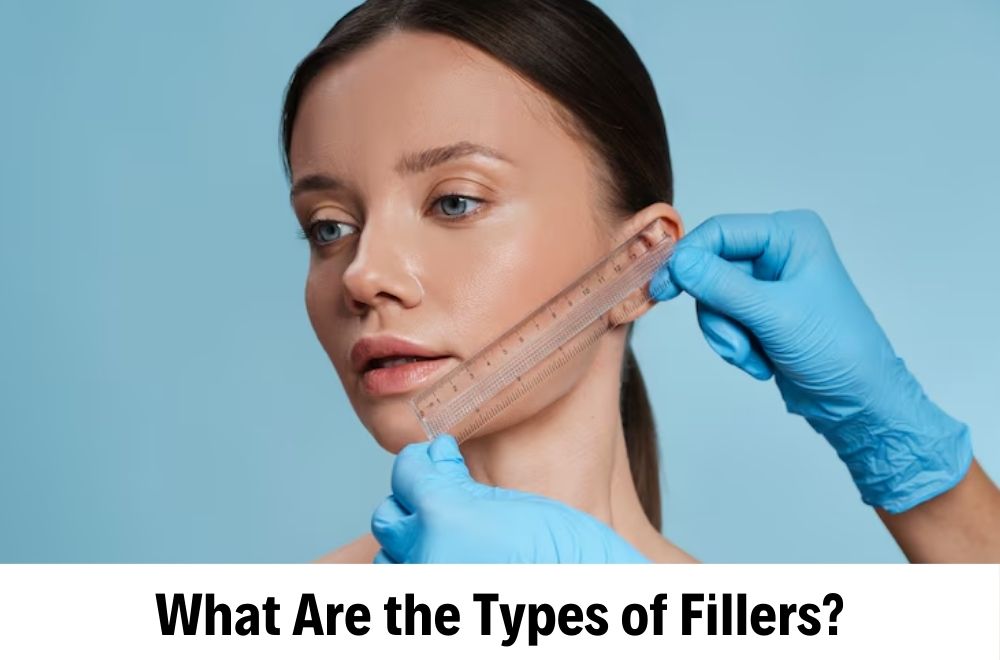Hello,
How Can We Help You?
Contact Form
Fill in the form and we will contact you as quickly as possible.
Contact us on Whatsapp
Scan with your camera app or click the QR code to start a conversation.


Fillers are cosmetic procedures used to correct various skin issues, shape facial features, or add volume. Fillers are substances injected into the skin to fill wrinkles, compensate for volume loss, or shape certain areas. Here are the commonly used types of fillers:
Hyaluronic Acid Fillers: Hyaluronic acid is a naturally occurring substance in the body with moisturizing properties. Hyaluronic acid fillers are commonly used to compensate for volume loss, fill wrinkles, and plump lips.
Calcium Hydroxylapatite Fillers: These fillers are an injectable form of the mineral calcium hydroxylapatite in a gel form. Calcium hydroxylapatite fillers can be used to shape facial features, tighten the skin, and support bone structure.
Poly-L-Lactic Acid Fillers: Poly-L-lactic acid is a substance that stimulates collagen production under the skin, providing fullness and firmness. Poly-L-lactic acid fillers are often used to redefine facial contours and treat deep wrinkles.
PMMA Fillers: Polymethylmethacrylate (PMMA) fillers are a gel-based filler containing small synthetic microspheres. These fillers are used for permanent volume increase and skin correction but must be applied carefully.
Fat Fillers: Fat fillers involve injecting the patient's own body fat. This method can be used to plump lips, shape cheeks, and add fullness to other areas experiencing volume loss.
Each type of filler is applied according to different skin issues and personal preferences. The type of filler to be used is determined based on the patient's needs, skin type, and desires. Therefore, it is important to consult with a dermatologist or aesthetic specialist before the filler procedure.

The filler procedure is usually performed by a dermatologist or aesthetic specialist in clinical settings. Before the procedure, the patient's needs are assessed, the correct filler material is selected, and detailed information about the procedure process is provided.
Preparation: Before the procedure, the area to be treated is cleaned, and an anesthetic cream or local anesthesia may be used. This helps reduce pain during the procedure.
Filler Application: After the preparation phase, the filler material is injected under the skin with a fine needle or catheter. The specialist carefully ensures the material is applied at the correct depth and amount.
Shaping and Correction: After the filler material is injected, the specialist carefully shapes the treated area and makes necessary corrections to achieve the desired result. This step may vary depending on the patient's wishes and the purpose of the treatment.
Check and Final Touches: Once the procedure is complete, the specialist conducts a final check and makes additional corrections if necessary. Mild swelling or redness may occur on the skin, so monitoring may be required for a certain period after the procedure.
Final Information: After the procedure, the patient is given post-procedure care instructions. These instructions include the best ways to protect your skin and manage potential side effects.
The filler procedure is generally quick and easy, often taking about 30 minutes to an hour. Normal daily activities can usually be resumed immediately after the procedure, but it is important to follow the doctor's instructions. There may be mild swelling, redness, or sensitivity in the treated area for the first few days post-procedure, but these typically resolve quickly.
The filler procedure is generally associated with mild discomfort or pain, but this can vary depending on the individual and the filler material used. The pain experienced during the procedure can depend on factors such as the type of filler material used, the area being treated, the individual's pain threshold, and the application technique.
Anesthesia: Local anesthesia is used before many filler procedures. This anesthesia numbs the treatment area, reducing or eliminating the sensation of pain. Anesthetic creams, gels, or injectable anesthetics are used to achieve numbness.
Pain Threshold: Each individual's pain threshold is different. Some people may feel almost no pain during the procedure, while others may experience mild discomfort. The pain threshold varies based on the individual's sensitivity and tolerance.
Filler Material: The type of filler material used can affect the pain felt during the procedure. Some filler materials are in gel form and contain anesthetic substances, making the procedure less painful, while other filler materials may be more dense or thick, causing more discomfort during the procedure.
Application Technique: The application technique used by specialists can also affect pain. Careful and quick injections can help minimize pain.
Personal Preferences and Expectations: Some patients may not want to feel any pain during the procedure and may therefore request more anesthesia. Specialists can use various pain management techniques to ensure the patient's comfort and satisfaction.
In general, the filler procedure is usually associated with mild discomfort and is tolerable for most patients. However, it is important to share any concerns or preferences for pain control with your specialist before the procedure. Your specialist will offer various options to provide you with the most suitable and comfortable experience.

The durability of fillers can vary depending on the type of filler material used, the application technique, the area treated, and the individual's metabolism. In general, fillers can provide different durations of permanence depending on the treated area and the type of filler used. Here are a few categories on how long fillers typically last:
Temporary Fillers: Many types of fillers are considered temporary. The effects of these fillers generally last between 6 and 18 months. Some filler materials like hyaluronic acid are gradually absorbed and broken down by the body over time, so their effects diminish gradually.
Semi-Permanent Fillers: Some filler materials can last longer and be effective for more than 18 months. These types of fillers usually have a thicker or denser structure and are absorbed more slowly by the body.
Permanent Fillers: Permanent fillers can be effective for years or a lifetime. Synthetic filler materials like PMMA (polymethylmethacrylate) can provide long-term durability. However, these types of fillers may carry more risks and can be difficult to correct or remove if needed.
The permanence of fillers is determined by the body's natural metabolism and the characteristics of the filler material. Factors such as an individual's lifestyle, skincare routine, and sun exposure can also affect how long the filler will last. To achieve more lasting results, the filler procedure may need to be repeated at certain intervals.
The longevity of fillers can vary from person to person, so it is important to discuss this topic in detail with your specialist before the filler procedure. Your specialist will determine the most suitable treatment plan to provide you with the best results.
Fillers can be used in various areas to achieve different aesthetic goals. The commonly treated areas include:
Lips: Lip fillers can enhance volume, improve shape, and define the contour of the lips. This can provide a fuller and more attractive appearance.
Cheeks: Cheek fillers can add volume to the cheeks, define the cheekbones, and provide a more youthful and vibrant look.
Nasolabial Folds: Nasolabial folds are the lines that extend from the sides of the nose to the corners of the mouth. Fillers can soften these lines and reduce their prominence.
Under-Eye Hollows: Fillers can be used to correct under-eye hollows and provide a fresher, more awake look.
Chin and Jawline: Chin and jawline fillers can enhance the definition and shape of the jawline and chin, providing a more balanced facial profile.
Forehead and Temples: Fillers can fill in hollows or depressions in the forehead and temples, providing a more youthful appearance.
Scars: Fillers can be used to reduce the appearance of scars by filling in the depressed areas and providing a smoother skin surface.
The treated areas can vary based on individual needs and goals. Specialists determine the most appropriate treatment areas and plan the procedure to achieve the desired results. The filler procedure can be customized according to the patient's facial structure, skin type, and preferences.
Fillers can offer immediate and visible results with minimal downtime, making them a popular choice for enhancing facial features and addressing various cosmetic concerns. To determine the most suitable treatment plan, it is important to consult with an experienced specialist.
The cost of the filler procedure can vary based on several factors. These factors can include:
Type of Filler Material: Different filler materials have different costs. For example, hyaluronic acid fillers and PMMA fillers may have different price ranges.
Amount of Filler Material Used: The amount of filler material used can also affect the price. The cost may vary depending on the volume and number of syringes used during the procedure.
Area Treated: The cost may vary based on the area being treated. For example, lip fillers and cheek fillers may have different price ranges.
Specialist's Experience and Clinic Location: The specialist's experience and the clinic's location can also affect the cost. Clinics in larger cities or more upscale areas may have higher prices.
Additional Services: Additional services provided before or after the procedure can also affect the cost. For example, services such as post-procedure care, consultation fees, or follow-up visits may be included in the total cost.
The cost of the filler procedure can vary widely based on these factors. To obtain detailed and accurate information about the cost, it is important to contact a specialist or clinic directly and discuss your specific needs and treatment plan.
The prices listed on our website are indicative and can vary based on individual circumstances. It is recommended to consult with a specialist for personalized cost information and treatment options.
Contact Form
Fill in the form and we will contact you as quickly as possible.
Contact us on Whatsapp
Scan with your camera app or click the QR code to start a conversation.